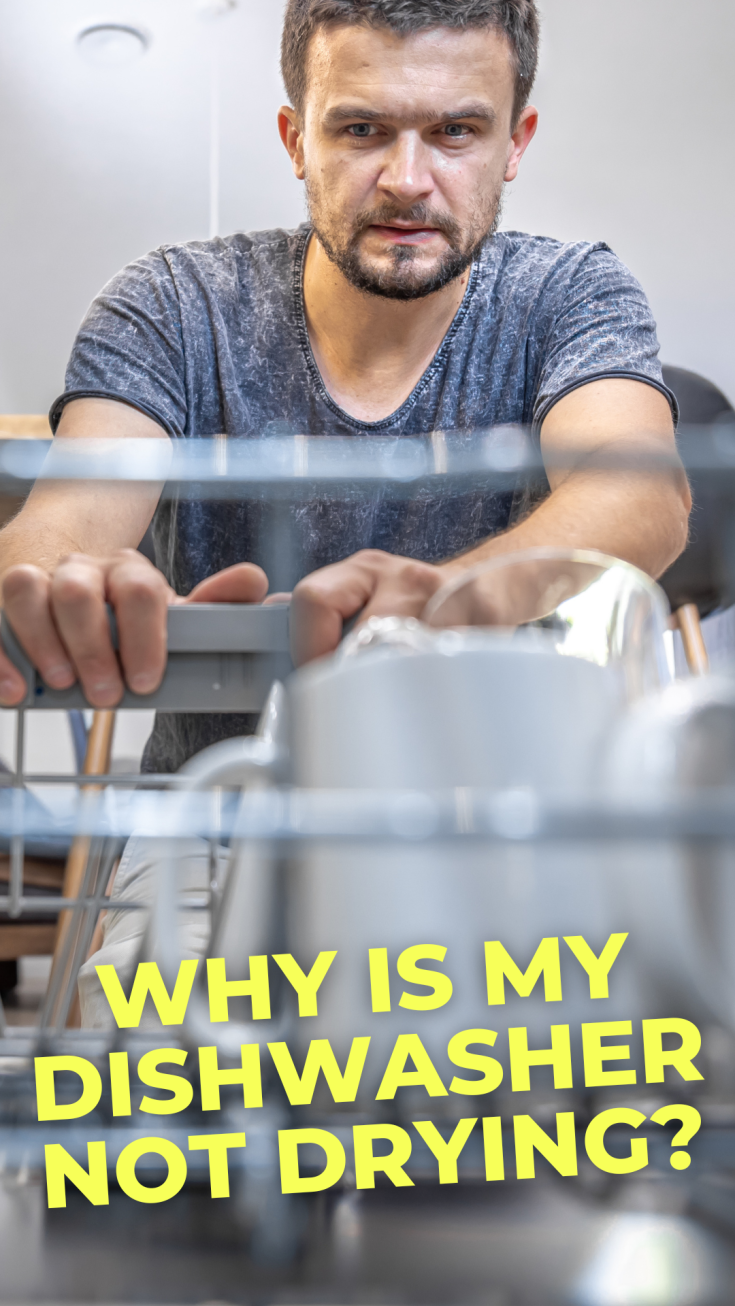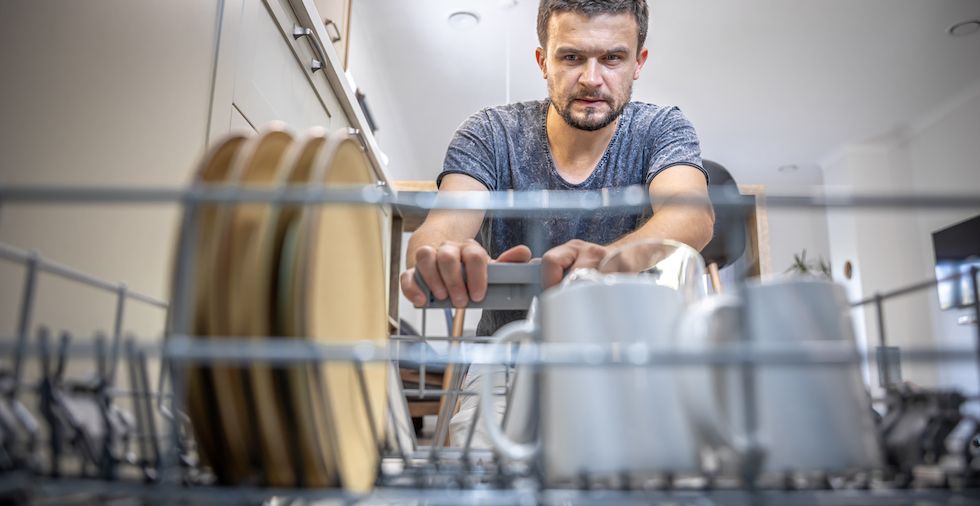- Why isn't my dishwasher drying properly?
- Does opening the dishwasher help to dry the dishes?
- Why is my dishwasher not drying on the top rack?
Let's face it, dishwashers have revolutionised kitchen cleanup, providing convenience and efficiency for busy households. These small but mighty appliances make our everyday lives much easier than they would otherwise be. But they don't always do a perfect job.
One common issue is the dishwasher's failure to dry the dishes effectively. If you've ever wondered, "Why is my Whirlpool dishwasher not drying?" or pondered whether opening the dishwasher door helps with drying, you've come to the right place. In this informative guide, we'll explore the answers to these questions and provide practical tips to ensure your dishes emerge sparkling clean and dry from your dishwasher.
Why isn't my dishwasher drying properly?
The answer isn't as straightforward as you imagine. A dishwasher's drying performance can be affected by various factors, and understanding these reasons can help troubleshoot the issue. Luckily, we've got you covered. Here are some common culprits behind a dishwasher's ineffective drying:
1. The rinse aid dispenser is empty or improperly set up:
Rinse aid is essential for optimal drying as it aids in the water sheeting process. If the rinse aid dispenser is empty or set too low, it may lead to water droplets clinging to the dishes instead of drying efficiently. That means that your dishes will be wet when the cycle is over.
2. Your dishwasher isn't getting hot enough
Adequate heat is crucial for effective drying. If the dishwasher's heating element is faulty or if the water temperature isn't hot enough, dishes may remain damp after the drying cycle. You may need a technician to look at your dishwasher soon.
3. You overload your dishwasher
Are you guilty of this sin? Overloading the dishwasher can obstruct proper air circulation, preventing the dishes from drying evenly. Ensure you arrange dishes properly, leaving enough space for air to circulate and moisture to evaporate.
While you're refreshing your loading skills, take a look at these things you should never put in the dishwasher.
4. You haven't chosen the right drying cycle
Selecting the appropriate drying cycle is essential. If you're using an energy-saving or air-dry cycle, the drying performance may not be as efficient as with a heated drying option. Check the manual to see how your dishwasher is set up for more details.
Does opening the dishwasher help to dry the dishes?
You might think you have the ideal solution to your dishwasher not drying. Many wonder if opening the dishwasher door after the drying cycle improves drying results.
While it may seem intuitive to promote better airflow, this method is generally ineffective. Opening the dishwasher door prematurely can release the built-up steam and heat, leading to longer drying times and potentially leaving dishes damp.
Modern dishwashers are designed to maintain heat and humidity during drying for optimal performance. To ensure efficient drying, allow the dishwasher to complete its drying cycle before unloading the dishes.
Avoid the temptation to open the dishwasher door prematurely, as it can hinder the drying process. Trust your dishwasher's engineering to provide the best results when cleaning and drying your dishes.
Why is my dishwasher not drying on the top rack?
Let's say you're stacking your dishes on the top rack. That could be a mistake. There's a right way to load a dishwasher. Get it wrong, and you could run into some problems. Dishes on the top rack might experience subpar drying for specific reasons:
1. The top spray arm is obstructed
The top spray arm is crucial in distributing water and heat evenly to the upper rack of the dishwasher. If it is obstructed or clogged, it can result in incomplete drying of items on the top shelf. Over time, mineral deposits or food particles may accumulate in the spray arm's small openings, reducing its ability to dispense water properly.
Solution: Regularly inspect and clean the top spray arm to ensure unobstructed water flow. To clean the spray arm, gently remove it from the dishwasher and rinse it under running water. Use a small brush or toothpick to clear debris from the spray arm's holes. This maintenance task will help restore the spray arm's effectiveness and improve drying performance on the top rack.
For more tips on how to clean a dishwasher, take a look at our other article.
2. The water pressure or temperature is wrong
The water temperature and pressure are critical factors that affect a dishwasher's cleaning and drying performance. Suppose the water pressure is too low or the water temperature is insufficient. In that case, it can impact the dishwasher's ability to effectively rinse and dry dishes, especially those on the top rack. Don't make this common mistake.
Solution: Check your home's water supply and make sure there are no issues with the water pressure. If the water pressure is too low, you may need to address plumbing issues or contact a professional for assistance. Additionally, make sure the dishwasher's heating element is functioning correctly to ensure that the water reaches the appropriate temperature for efficient drying.
3. You've loaded your dishwasher badly
Not to point fingers here, but you may not be loading your dishwasher correctly. How you load your dishwasher can significantly impact its drying performance, especially on the top rack. If tall items or large cookware obstruct the top spray arm or stop the water flow to the top shelf, it can result in uneven drying or wet dishes.
Solution: Take care when loading the dishwasher, especially on the top rack. Arrange items so they do not block the spray arm's rotation and allow proper water circulation. Place taller items and cookware towards the back or sides of the dishwasher to ensure they don't interfere with the spray arm's movement.
Next, check out these things you didn't know you could clean in the dishwasher.
4. You've selected "non-heat drying"
Some dishwashers offer multiple drying cycle options, including heated drying and air-drying or energy-saving modes. If you have selected an air-drying or energy-saving cycle, the drying performance may be less efficient, particularly on the top rack.
Solution: If possible, choose the heated drying option for optimal drying results. This setting uses the dishwasher's heating element to produce hot air, helping dishes to dry more effectively. While the air-drying cycle is energy-efficient, it may leave dishes damp, especially on the top rack.
Now you have the inside scoop, you can make some changes. With these solutions, you can improve the drying performance on the top rack of your dishwasher and enjoy dry and spotless dishes after every wash cycle. Regular maintenance, proper loading techniques, and selecting the appropriate drying cycle will help ensure that your dishwasher operates at its best, delivering the results you expect from a high-quality appliance. For more information on whether you need a replacement, take a look at our article and find out how long dishwashers last and learn what you should do if your dishwasher pods aren't dissolving.
Q&A
Did we miss something? If you're still looking for answers about how to look after your dishwasher, you've come to the right place. Take a look at our frequently asked questions.
What should you do if your Whirlpool dishwasher is not drying?
If your Whirlpool dishwasher is not drying properly, it can be frustrating, but with some troubleshooting. You can resolve the issue and achieve dry dishes after every wash. Remember to check the rinse aid dispenser, select the appropriate drying cycle, and avoid overloading the dishwasher to promote effective drying. Additionally, ensure that the spray arms are unobstructed and the water temperature is adequate for optimal results.
Does the heating element in a dishwasher heat the water?
Your dishwasher has its own heating element that is built into the unit. However, it is also connected to your home's hot water. The appliance gets the water from your central system and may heat it using the element.
Is it worth getting a dishwasher repaired?
If your dishwasher is not doing the job it's supposed to do, it may be worth looking at repairing it. However, you have to weigh up how much that will cost. If the total price of fixing your dishwasher will likely be more than a new one, you should cut your losses. According to Which, you can get a new dishwasher that works well for less than £200.
What are the best dishwasher brands?
If you're looking for a new dishwasher, it pays to look into the best brands out there. According to BBC Good Food, some of the best include Bosch dishwashers, Beko dishwashers, and Samsung dishwashers. You may also want to try Whirlpool dishwashers.
Which brand of dishwasher is the most reliable?
While there are many different dishwasher brands, you need to choose the most reliable. Reader's Digest recently rated Bosch as the best dishwasher brand. However, you should always read the reviews before you decide which appliance to invest in.
Did you fix the problem? Let us know in the comments below!


Leave a Reply